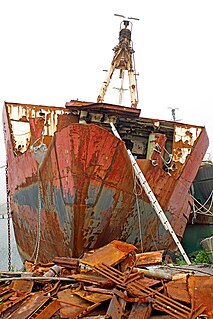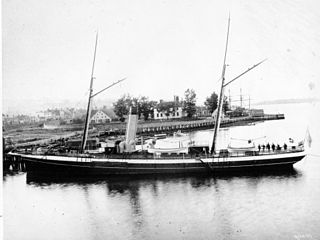
CCGS Alexander Henry is a former Canadian Coast Guard light icebreaker and buoy tender that served on the Great Lakes from 1959 to 1984. In 1986, the vessel was handed over to the Marine Museum of the Great Lakes in Kingston, Ontario for preservation as a museum ship. Previously, during the summer months the vessel was also operated as a bed and breakfast. In 2017, the ship was sold to the Lakehead Transportation Museum Society in Thunder Bay, Ontario and in June, was relocated to the Pool 6 site on the town's harbour front, where Alexander Henry continues as a museum ship.

HMCS Malaspina was a Canadian government fisheries patrol vessel pressed into service with the Royal Canadian Navy in 1917 and again in 1939 and which therefore saw service during the First World War and Second World War. The vessel was constructed in 1913 in Dublin, Ireland and patrolled the fisheries along the West Coast of Canada.

CCGS John A. Macdonald was a Canadian Coast Guard heavy icebreaker. She was named after The Right Honourable, Sir John Alexander Macdonald, the first Prime Minister of Canada. The ship was commissioned into the Canadian Department of Transport's Marine Service in 1960 using the prefix "Canadian Government Ship" (CGS). The vessel was transferred in 1962 into the newly created Canadian Coast Guard (CCG) and served with distinction until being decommissioned in 1991, and replaced by the then-chartered CCGS Terry Fox.
CCGS Brant was a Canadian Coast Guard vessel in service between 1928 and 1966. Stationed on the East Coast of Canada, Brant was deployed as a navigation aids tender. Brant was the last coal-burning vessel in Canadian government service.
CCGS N.B. McLean was a Canadian Coast Guard icebreaker. Constructed in 1930 at Halifax Shipyards, she entered service as CGS N.B. MacLean and served in the Department of Transport's Marine Service, using the prefix "Canadian Government Ship". The ship was transferred into the newly created Canadian Coast Guard in 1962. She served in the St. Lawrence River and Gulf of St. Lawrence until she was decommissioned in 1979, and taken to Taiwan to be scrapped in 1989. She was replaced by CCGS Pierre Radisson.

CCGS Tupper was a Canadian Coast Guard ice-strengthened buoy tender that served from 1959 to 1998. The vessel spent her entire career on the East Coast of Canada. Following her Canadian service, Tupper was sold to private interests with the intention of converting her to a yacht, but the conversion never happened and the vessel moved about Halifax Harbour, suffering a fire in 2008 before being sold for scrap in 2011. The vessel was not scrapped and the Canadian Coast Guard was forced to address the pollution concerns of the abandoned vessel in 2021.

CCGS Simcoe was a Canadian Coast Guard buoy tender and light icebreaker. The second vessel of the name in Canadian government service, Simcoe was in service from 1962 to 2007 based out of the Coast Guard base at Prescott, Ontario working the Great Lakes and Saint Lawrence Seaway. In 2008 the ship was sold to commercial interests.
CCGS D'Iberville was a Canadian Coast Guard icebreaker that was in service from 1952 to 1983 and was Canada's first modern icebreaker. The ship commissioned as CGS D'Iberville for the Department of Transport's Marine Service, using the prefix "Canadian Government Ship", D'Iberville was transferred into the newly-created Canadian Coast Guard in 1962. When launched, she was the largest icebreaker in use by Canada post-World War II until CCGS John A. Macdonald was put in service. In 1984, the icebreaker was renamed Phillip O'Hara before returning to her old name in 1988. In 1989 the vessel was sold for scrap and broken up at Kaohsiung, Taiwan.
CCGS Wilfred Templeman was a Canadian Coast Guard fisheries research vessel that entered service 1981 with the Department of Fisheries and Oceans. In 1995 the Fisheries and Oceans and Canadian Coast Guard fleets were amalgamated and Wilfred Templeman joined the Canadian Coast Guard. The research vessel patrolled the coast off Newfoundland and Labrador. In 2011, the vessel was taken out of service, sold to commercial interests and renamed Blain M.

CGS Simcoe was a lighthouse supply and buoy vessel of the Canadian government acquired for service on the Great Lakes. Entering service in 1909, Simcoe was active until 1917 when the vessel foundered while transiting to Saint John, New Brunswick with the loss of 44 persons.

CGS Vigilant was a Fisheries Protection patrol vessel employed on the Canadian Great Lakes. Completed in 1904, the vessel remained in service on the Great Lakes until 1924. The vessel was then chartered by the Canadian Customs Preventive Service until 1929 for service on the East Coast of Canada. The ship was sold to private interests and converted to a barge and remained in service until 1956 when the vessel was broken up.

CGS Aberdeen was a Canadian Government Ship launched in 1894, which served as a lighthouse supply and buoy vessel. The vessel served on the East Coast of Canada until 1923, when the vessel ran aground on Seal Island, Nova Scotia.

CGS Acadia was a fisheries patrol vessel of the Canadian Department of Marine and Fisheries from 1885 to 1909. The ship began life as the yacht Yosemite, constructed in the United States in 1880. After being acquired in 1885 by Canada and renamed Acadia, the ship served in the Atlantic fisheries, enforcing fisheries regulations in Canadian waters. The ship was taken out of service in 1909 and sold for scrap and Acadia's registry was closed in 1910.
CCGS Simon Fraser was a buoy tender operated by the Canadian Coast Guard. The vessel entered service in 1960 with the Department of Transport's Marine Fleet, before being transferred to the newly formed Canadian Coast Guard in 1962. The buoy tender served on both coasts of Canada and was used for search and rescue duties along the West Coast of Canada. The ship was loaned to the Royal Canadian Mounted Police in 2000 and transited the Northwest Passage, circumnavigating North America in the process. The ship was taken out of service in 2001 and sold to private interests. In 2006, the vessel reappeared as a yacht using the same name.

CCGS Sir Humphrey Gilbert was a Canadian Coast Guard light icebreaker and buoy tender and now a privately owned Arctic icebreaker Polar Prince. The ship entered service with the Department of Transport Marine Service in 1959 and transferred to the newly created Canadian Coast Guard in 1962, active until 1986. The icebreaker was sold to private interests in Newfoundland and the ship sat idle after 2001 until resold in 2009 to GTX Technology Canada Limited and renamed Polar Prince. Rebuilt, the icebreaker is now plying the waters of the Arctic Ocean. In 2017, the vessel was temporarily rechristened Canada C3 and used for a high-profile voyage around Canada's three maritime coasts as part of the nation's 150th anniversary.

CGS Minto was one of the Government of Canada's first icebreakers. She was modeled after CGS Stanley, Canada's first effective icebreaker, but was slightly longer and more powerful. Like her predecessor, her primary winter duties were keeping Prince Edward Island connected to the mainland—one of the conditions under which the province had entered Confederation. The ship entered service in 1899 and remained on the East Coast of Canada until 1915, when Minto was sold to the Russian Empire. Transferred in November, she became Ivan Susanin, and was tasked with keeping northern ports open during the war. Her name was changed to Leitenant Dreyer in 1920 after being taken over the Soviet Navy and Skuratov in 1921. The ship was wrecked in the Barents Sea in 1922.
CCGS J.E. Bernier was a Canadian Coast Guard medium Arctic icebreaker with a steel hull. The vessel was in service from 1967 to 2006. The ship was initially based at Quebec City but finished her career at St. John's. The ship was named for Joseph-Elzéar Bernier, captain of CGS Arctic which explored and monitored the eastern Arctic for the Government of Canada in the early 20th century. The vessel was sold in 2006 to private interests.

CGS Kestrel was employed as a Government of Canada Fisheries Protection vessel on the Pacific Coast. Completed in 1899 by Alfred Wallace shipyards in Vancouver, British Columbia she entered into service in 1903 and remained in government service after the creation of the Royal Canadian Navy in 1910 until she was sold in 1912. The vessel was broken up in 1931.

CCGS Ernest Lapointe was a Canadian Coast Guard light icebreaker that served for 37 years. Completed in 1941, Ernest Lapointe was taken out of service in 1978. The ship was active along the East Coast of Canada and in the Saint Lawrence River. In 1980, the vessel was turned into a museum ship in Quebec.

CGS C.D. Howe was a Canadian Arctic patrol vessel tasked with controversial missions that served first with the Department of Transport, then the Canadian Coast Guard. Conceived as a way to make Canada's presence in the Arctic more visible, C.D. Howe entered service in 1950. The ship would make an annual voyage to Canada's north in the summer months, visiting remote communities to resupply them and to provide medical and dental services. The patrol vessel would sometimes remove members of Aboriginal communities to the south for further treatment. The ship was also involved in a forced resettlement of Inuit families in the High Arctic. During winter months, C.D. Howe provided services in the Gulf of St. Lawrence. In 1962, the ship joined the Canadian Coast Guard and was given the new prefix CCGS. C.D. Howe was deemed obsolete in 1969 and taken out of service. In 1970 the vessel was sold, becoming an accommodation vessel in Greenland before being broken up for scrap in 1975.













